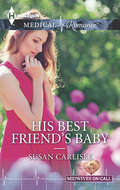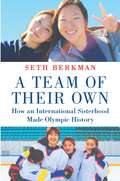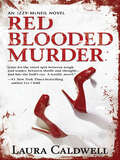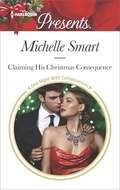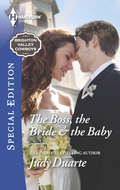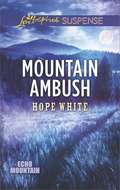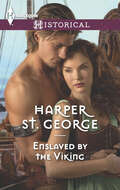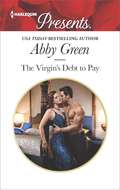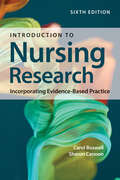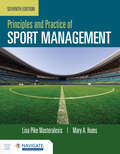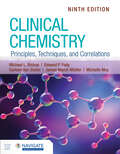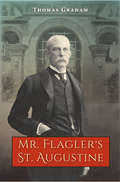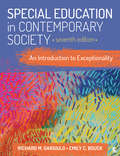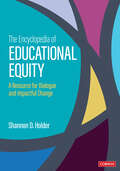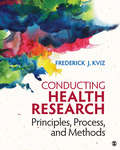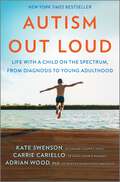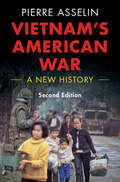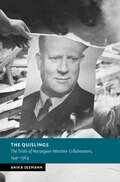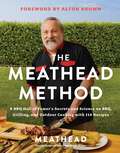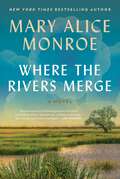- Table View
- List View
His Best Friend's Baby (Midwives On-Call #6)
by Susan CarlislePregnant on his doorstep! Former army medic Ryan Matthews loves his work as a midwife-bringing life into the world helps him forget losing his best friend in Iraq. But when Ryan finds his friend's pregnant wife on his doorstep, his whole world is turned upside down... For Ryan, opening his door to Phoebe is one thing-but opening his heart is a whole different matter. Until one scorching, unforgettable kiss unleashes emotions he locked away long ago...and Ryan finds himself fighting against a love he's never dared to believe exists!
A Team of Their Own: How an International Sisterhood Made Olympic History
by Seth BerkmanA December Stephen Curry Book Club PickOne of ESPN’s 25 Can’t Miss Books of 2019“A feel-good story.”—New York Times Book Review“This isn’t simply a sports book. Rather, it’s a book about inspiring and courageous women who just happened to be hockey players.”—Korea TimesThe inspiring, unlikely story of the American, Canadian, South Korean and even North Korean women who joined together to form Korea’s first Olympic ice hockey team.Two weeks before the opening ceremony of the 2018 Winter Olympics, South Korea’s women’s hockey team was forced into a predicament that no president, ambassador or general had been able to resolve in the sixty-five years since the end of the Korean War. Against all odds, the group of young women were able to bring North and South Korea closer than ever before.The team was built for this moment. They had been brought together from across the globe and from a wide variety of backgrounds—concert pianist, actress, high school student, convenience store worker—to make history. Now the special kinship they had developed would guide them through the biggest challenge of their careers. Suddenly thrust into an international spotlight, they showed the powerful meaning of what a unified Korea could resemble.In A Team of Their Own, Seth Berkman goes behind the scenes to tell the story of these young women as they became a team amid immense political pressure and personal turmoil, and ultimately gained worldwide acceptance on a journey that encapsulates the truest meanings of sport and family.
Red Blooded Murder (An Izzy McNeil Novel #2)
by Laura CaldwellChicago is the Windy City, and these days the winds of change are whipping Izzy McNeil's life all over the map. A high-profile job on Trial TV lands her in the hot seat. After a shocking end to her engagement, she finds herself juggling not only her ex-fiancé, but a guy she never expected. And a moonlighting undercover gig has her digging deep into worlds she barely knew existed.But all of this takes a backseat when Izzy's friend winds up brutally murdered. Suddenly, Izzy must balance the demands of a voracious media and the knowledge that she didn't know her friend as well as she thought.
NIGHTHAWK (Conard County #8)
by Rachel LeeConard County"Conard County is a wonderful place to visit."-New York Times Bestselling Author Heather Graham PozzessereHE WAS HER ONLY HOPEEsther Jackson needed Craig Nighthawk's protection. The father she'd helped put away for murder was now seeking her out, so against her reclusive nature, she welcomed the darkly handsome Nighthawk into her home, hoping he could keep her safe.SHE WAS HIS ONLY PEACECraig knew all about fear and isolation After all, he was still being tried and convicted by the people of Conard County for a crime he hadn't committed. All he wanted was to be left alone. Until he met Esther, and discovered in her loving arms a peace he would safeguard at any cost....Conard County. Where the Wyoming sky spreads bold and blue above men and women who draw their strength from the land and from the bonds of the love they share.
Claiming His Christmas Consequence: A Passionate Christmas Romance (One Night With Consequences)
by Michelle Smart"You have one new message..." "Know this, Catalina. You might be a princess, you might be wearing my ring, you might have taken 200,000 euros of my money...but you are carrying my child, and I will find you." Catalina had never stepped out of line, until one stolen Christmas night of irresistible passion with French billionaire Nathanial Giroud changed her life forever. Now, hidden in the Pyrenees, Catalina is determined to protect the small life growing within her from the anguish of her own royal upbringing. Even if she has to defy the husband she so desperately craves! When one night...leads to pregnancy!
The Boss, the Bride & the Baby: Do You Take This Maverick? The Boss, The Bride And The Baby A Reunion And A Ring (Brighton Valley Cowboys #1)
by Judy DuarteFROM CEO...TO DADDY? Texas tycoon Jason Rayburn had been raised to take charge. To make decisions. To avoid emotion. So when he's forced to return to Brighton Valley to inventory his grandmother's small-town ranch for sale, the executive delegates the work to his new hire, local waitress Juliana Bailey. Jason never mixes business with pleasure, but even he can't ignore his attraction to the redheaded beauty-in spite of the secret she's clearly hiding... For Juliana, the job at the Leaning R was too good to be true, offering her a place to lie low until she could confess her pregnancy to her family-and avoid local scandal. But she hadn't counted on the searing sparks flying with the corporate cowboy! Now, the expectant assistant knows the billionaire boss is no family man. But she'll fight for the right to show him he's got daddy potential!
Mountain Ambush: Faith in the Face of Crime (Echo Mountain)
by Hope WhiteMARKED FOR MURDER A search-and-rescue mission turns deadly when Dr. Kyle Spencer is nearly killed by an assailant in the mountains. And when EMT Maddie McBride saves the doctor just in time, they're both targeted-but no one knows why. One thing's clear, though-from the moment Maddie finds Echo Mountain's most eligible bachelor left for dead, she can't stop thinking about him. But she's always been wary of the town's Dr. Dreamboat. And Spence's scarred heart's been shuttered since a childhood tragedy. As someone stalks the injured doctor's every move, though, Spence realizes that he needs the determined Maddie in his corner. However, he can't be sure their partnership will be enough to save them...especially against a seemingly all-knowing foe who's got them both in his deadly sights.
Enslaved by the Viking: An Intense Story of Forbidden Passion (Viking Warriors #1)
by Harper St. George"From this day forward, you are mine." The moment Merewyn sets eyes on the warrior standing atop a Viking raiding ship, something inside her stirs. By all rights, she should fear him, should run from him, yet she cannot help but be drawn to him. Eirik has never before taken a woman captive, yet Merewyn inspires a longing that calls to the darkness within him. He takes her back to his homeland as his slave, where they finally succumb to passion. And as the lines between captor and captive blur, Eirik realizes they have crossed into dangerous territory...
The Virgin's Debt to Pay: An Emotional and Sensual Romance (Mills And Boon Modern Ser.)
by Abby GreenIndebted to the billionaire…And he will collect!Nessa must appeal to notorious tycoon Luc’s better nature to exonerate her brother of theft. But Luc is the most merciless—and sinfully attractive—man Nessa’s ever met! Until the debt is settled, he’ll hold her as his captive. And when undeniable attraction overwhelms them both, it becomes clear that Nessa’s innocence is the real price to pay…!
Introduction to Nursing Research: Incorporating Evidence-Based Practice
by Carol Boswell Sharon CannonIntroduction to Nursing Research: Incorporating Evidence-Based Practice, Sixth Edition provides a solid foundation for teaching and learning the basics of evidence-based practice. Giving students the tools they need to become effective practitioners, this text is a comprehensive guide for integrating evidence-based practice and research into the day-to-day work of nursing. Mastery of research will allow students training to be nurses to provide quality patient care and improve healthcare outcomes overall. As in previous editions, the authors take a thoughtful and practical approach by combining research, quality improvement, and evidence-based practice. The Sixth Edition focuses on the connection between research and evidence-based practice as a foundation for safe and effective health care. Demonstrating research establishes a foundation that will lead students to evidence-based practice.
Principles and Practice of Sport Management with Navigate Advantage Access
by Lisa Pike Masteralexis Mary HumsOffering an overview of the sport industry and coverage of the foundational knowledge and skills required of the today's sport manager, Principles and Practice of Sport Management is devoted to educating students on the various industry segments where they can focus their careers. After detailing the history and various principles – from management and marketing to finance, legal and ethical – the book delves into key sports management segments, discussing the skills needed in those sectors, the types of positions available, and the curre
Clinical Chemistry: Principles, Techniques, and Correlations with Navigate Advantage Access
by Michael L. Bishop Edward P. Fody Carleen Van Siclen James March MistlerClinical Chemistry: Principles, Techniques, and Correlations, Ninth Edition is the most student-friendly clinical chemistry text available today. The Ninth Edition keeps students at the forefront of what continues to be one of the most rapidly advancing areas of laboratory medicine with clear explanations that balance analytic principles, techniques, and correlation of results with coverage of disease states. The book not only demonstrates the how of clinical testing, but also the what, why, and when of testing correlations to help students develop the knowledge and interpretive and analytic skills they’ll need in their future careers.
Mr. Flagler’s St. Augustine
by Thomas GrahamFlorida Book Awards, Bronze Medal for Florida Nonfiction Florida Historical Society Charlton Tebeau Book AwardArguably no man did more to make over a city—or a state—than Henry Morrison Flagler. Almost single-handedly, he transformed the east coast of Florida from a remote frontier into the winter playground of America’s elite.Mr. Flagler’s St. Augustine tells the story of how one of the wealthiest men in America spared no expense in transforming the country’s “Oldest City” into the “Newport of the South.” He built railroads into remote areas where men feared to tread and erected palatial hotels on swampland. He funded hospitals and churches and improved streets and parks. The rich and famous flocked to his invented paradise.In tracing Flagler’s life and second career, Thomas Graham reveals much about the inner life of the former oil magnate and the demons that drove him to expand a coastal empire southward to Palm Beach, Miami, Key West, and finally Nassau. Graham also gives voice to the individuals history has forgotten: the women who wrote tourist books, the artists who decorated the hotels, the black servants who waited tables, and the journalists who filed society columns in the newspapers.Filled with fascinating details that bring the Gilded Age to life, this book will stand as the definitive history of Henry Flagler and his time in Florida.
Special Education in Contemporary Society: An Introduction to Exceptionality
by Richard M. Gargiulo Emily C. BouckSpecial Education in Contemporary Society: An Introduction to Exceptionality offers a comprehensive, engaging, and readable introduction to the dynamic field of special education. Grounded in research and updated to reflect the most current thinking and standards of the field, this book provides students with the knowledge, skills, attitudes, and beliefs that are crucial to constructing learning environments that allow all students to reach their full potential. Authors Richard M. Gargiulo and Emily C. Bouck encourage a deep awareness and understanding of the "human" side of special education, providing students with a look into the lives of exceptional students and their families, as well as the teachers that work with exceptional persons throughout their lives. The Seventh Edition maintains the broad context and research focus for which the book is known while expanding on current trends and contemporary issues to better serve both pre-service and in-service teachers of exceptional individuals. This title is accompanied by a complete teaching and learning package.
The Encyclopedia of Educational Equity: A Resource for Dialogue and Impactful Change
by Shannon D. HolderUnlock the language of educational equity to create meaningful change in schools. As educators, professors, policymakers, and advocates work to dismantle systemic barriers and advance equity in education, they must begin with a common understanding of the words that shape their actions. The Encyclopedia of Educational Equity offers over 650 carefully curated terms, concepts, and strategies essential for productive conversations about equity. This powerful tool will provide readers with a deep understanding of fundamental concepts in equity—like "color blindness," "gender expansive," and "meritocracy"—enabling them to identify challenges and craft solutions to improve educational outcomes for all. Key features include: Micro-Checks to reflect and interrogate personal beliefs Equity timeline notes embedded throughout, which provide essential historical context for many terms Supplemental resources including tips for bias-free language, a list of frequently misused terms, critical thinking prompts for professional learning communities (PLCs), and a guide to further reading Evidence-based strategies and best practices for achieving equity in education, interwoven throughout the text Whether you are a novice or a veteran, this encyclopedia is user-friendly and accessible to anyone working toward equity—from educators and students to administrators, researchers, and community advocates.
Conducting Health Research: Principles, Process, and Methods
by Frederick J. KvizConducting Health Research: Principles, Process, and Methods presents an integrated and practical introduction to the principles and strategies for planning, implementing, reporting, and assessing health sciences research. Comprehensive in its breadth and depth, with an accessible writing style, this text prepares students in public health and related fields to be adept researchers and consumers of health research. Through real-world examples and step-by-step guidance, Frederick J. Kviz provides students with the skills they need to: identify and evaluate research strengths and limitations as practitioners; to actually perform the various core aspects of research; and to choose among alternative methods when making decisions about health practice, policy, and future research needs.
Special Education in Contemporary Society: An Introduction to Exceptionality
by Richard M. Gargiulo Emily C. BouckSpecial Education in Contemporary Society: An Introduction to Exceptionality offers a comprehensive, engaging, and readable introduction to the dynamic field of special education. Grounded in research and updated to reflect the most current thinking and standards of the field, this book provides students with the knowledge, skills, attitudes, and beliefs that are crucial to constructing learning environments that allow all students to reach their full potential. Authors Richard M. Gargiulo and Emily C. Bouck encourage a deep awareness and understanding of the "human" side of special education, providing students with a look into the lives of exceptional students and their families, as well as the teachers that work with exceptional persons throughout their lives. The Seventh Edition maintains the broad context and research focus for which the book is known while expanding on current trends and contemporary issues to better serve both pre-service and in-service teachers of exceptional individuals. This title is accompanied by a complete teaching and learning package.
Conducting Health Research: Principles, Process, and Methods
by Frederick J. KvizConducting Health Research: Principles, Process, and Methods presents an integrated and practical introduction to the principles and strategies for planning, implementing, reporting, and assessing health sciences research. Comprehensive in its breadth and depth, with an accessible writing style, this text prepares students in public health and related fields to be adept researchers and consumers of health research. Through real-world examples and step-by-step guidance, Frederick J. Kviz provides students with the skills they need to: identify and evaluate research strengths and limitations as practitioners; to actually perform the various core aspects of research; and to choose among alternative methods when making decisions about health practice, policy, and future research needs.
The Encyclopedia of Educational Equity: A Resource for Dialogue and Impactful Change
by Shannon D. HolderUnlock the language of educational equity to create meaningful change in schools. As educators, professors, policymakers, and advocates work to dismantle systemic barriers and advance equity in education, they must begin with a common understanding of the words that shape their actions. The Encyclopedia of Educational Equity offers over 650 carefully curated terms, concepts, and strategies essential for productive conversations about equity. This powerful tool will provide readers with a deep understanding of fundamental concepts in equity—like "color blindness," "gender expansive," and "meritocracy"—enabling them to identify challenges and craft solutions to improve educational outcomes for all. Key features include: Micro-Checks to reflect and interrogate personal beliefs Equity timeline notes embedded throughout, which provide essential historical context for many terms Supplemental resources including tips for bias-free language, a list of frequently misused terms, critical thinking prompts for professional learning communities (PLCs), and a guide to further reading Evidence-based strategies and best practices for achieving equity in education, interwoven throughout the text Whether you are a novice or a veteran, this encyclopedia is user-friendly and accessible to anyone working toward equity—from educators and students to administrators, researchers, and community advocates.
Autism Out Loud: Life with a Child on the Spectrum, from Diagnosis to Young Adulthood
by Kate Swenson Carrie Cariello Adrian WoodAN INSTANT NEW YORK TIMES BESTSELLER!In this moving narrative of resilience and pure love, three mothers share their experiences and learnings about life alongside autism -- From the creators of Finding Cooper's Voice, What Color is Monday?, and Tales of an Educated DebutanteKate Swenson, Adrian Wood and Carrie Cariello are from different parts of the country and backgrounds, but they were brought together by a singular experience: they are each a mother to a child with autism. Together they have shared laughter, tears, victories and the unconditional love that molds their lives.Kate, Adrian and Carrie have children with very different autism profiles, and in Autism Out Loud they write about their unique experiences on a variety of topics, from diagnosis to caregiving, schooling and aging. Through their varied stories and lessons they&’ve learned, these incredible women provide a glimpse of what to expect on the autism journey and show parents that they are not alone. Written with honesty and heart, the stories within these pages serve as a reminder that even amid the storms of life, there is always hope and beauty to be found. A tribute to the unparalleled love of mothers, this inspiring book illuminates the joys, challenges and everyday miracles of life on the spectrum.
Vietnam's American War: A New History (Cambridge Studies in US Foreign Relations)
by Pierre AsselinThe American war in Vietnam was so much more than the sum of its battles. To make sense of it, we must look beyond the conflict itself. We must understand its context and, above all, the formative experiences, worldview, and motivations of those who devised communist strategies and tactics. Vietnam's American War, now in its second edition, remains a story of how and why Hanoi won. However, this revised and expanded edition offers more extensive and nuanced insights into Southern Vietnamese history, politics, and society. It puts to rest the myth of Vietnamese national unity by documenting the myriad, profound local fractures exacerbated by US intervention. It also includes over thirty-five new images intended to highlight that the Vietnam War was, fundamentally, a Vietnamese civil war and tragedy. This new edition is as richly detailed as it is original, eye-opening, and absorbing.
The Quislings: The Trials of Norwegian Wartime Collaborators, 1941–1964 (New Studies in European History)
by Anika SeemannThe Norwegian 'treason trials' were the most extensive post–Second World War 'reckoning' with wartime collaboration in all of Europe. Following the war, tens of thousands of Norwegians were sentenced for their wartime actions, including the notorious leader of Norway's collaborationist party Nasjonal Samling, Vidkun Quisling. And yet many wartime actions also went unpunished, including, in the vast majority of cases, violence perpetrated against Norway's Jewish minority. The Quislings examines how the Norwegian authorities planned, implemented and interpreted this reckoning between 1941 and 1964. In doing so, it looks at the broader political purposes the treason trials served, how these changed over time and the mechanisms that brought these changes about. This wide-ranging study argues that the trials were not driven by the agenda of any one institution or group. Instead, their final shape was the result of a complex process of weighing up demands for legal form and consistency against a fast-changing political and social environment.
Springs - English Course Book Second Year Pre-University 2021-2022 - Karnataka University
by Department of Pre University Education Government of KarnatakaThe Second PUC English Course Book (2021–2022) by the Department of Pre-University Education, Karnataka, is an anthology curated to foster literary appreciation and strengthen English language skills among pre-university students. It comprises a thoughtfully chosen mix of global and regional literary texts—short stories, poems, and a play—designed to spark curiosity, critical thinking, and cultural awareness. Notable inclusions are excerpts from Shakespeare’s Romeo and Juliet, Leo Tolstoy’s Too Dear!, Kahlil Gibran’s On Children, and Vandana Shiva’s essay Everything I Need to Know I Learned in the Forest. Each unit is supplemented with pre-reading activities, glossaries, comprehension questions, and extended activities to support layered understanding and application. The book emphasizes contemporary educational priorities such as sustainability, empathy, equity, and digital literacy, while reinforcing the importance of grammar and vocabulary through an integrated workbook. This revised edition aims to promote both linguistic competence and ethical sensitivity among learners in alignment with the National Curriculum Framework.
The Meathead Method: A BBQ Hall of Famer's Secrets and Science on BBQ, Grilling, and Outdoor Cooking with 114 Recipes
by Meathead“The only book on outdoor cookery you’ll ever need.” —Alton BrownAmazon May 2025 Best of the Month PickThe Meathead Method is where barbecue goes next. In the follow-up to his New York Times bestseller Meathead: The Science of Great Barbecue and Grilling, BBQ Hall of Famer and founder of AmazingRibs.com, Meathead presents a guide to new methods for great outdoor cooking with 114 creative and inspiring recipes. The Meathead Method is a toolbox to elevate all your cooking, outdoors and indoors.Learn the basics of great barbecue, grilling, and griddling plus new methods and science not covered in his first book (or any other): brinerades; sous vide que; koji; wok cooking on a charcoal chimney; smoking with tea, herbs, and spices; building your own rubs and sauces; why foods stick to metal; how to safely deep fry on a gas grill; how enzymes work; dry brining; the inverse square law; the hockey stick; 2- and 3-zone setups; the reverse sear; how to beat the stall; the Smoking Gun; injections; why butter basting doesn’t work the way you think it does; neither does beer can chicken; nor do marinades; ponassing and spatchcocking (get your mind out of the gutter); and much more!You’ll also learn how to use out-of-the-BBQ-box ingredients like black garlic, gochujang, yuzu, miso, zhug, and tare sauce, and recipes showcasing Meathead’s methods, including: The secret recipes of competition championsThe Ultimate Prime RibPho with Leftover Brisket and Smoked Bone BrothMussels on Smoked FettucineMiso Maple Black Cod à la NobuVichyssoiseImproved Nashville Hot ChickenRed Pepper RisottoPineapple Foster
Where the Rivers Merge: A Novel
by Mary Alice Monroe“Wade into the Lowcountry of South Carolina with Mary Alice Monroe's sweeping Southern epic."—People"This is book club fiction at its finest!" —Lisa Wingate, #1 New York Times bestselling author From New York Times bestselling author Mary Alice Monroe comes her highly anticipated Where the Rivers Merge, the first of two epic and triumphant novels celebrating one intrepid woman's life across multiple generations in the American South.1908: The Lowcountry of South Carolina is at the cusp of change. Mayfield, the grand estate held for generations by the Rivers family, is the treasured home of young Eliza. A free spirit, she refuses to be confined by societal norms and spends her days exploring the vast property, observing wildlife, and riding horses. But the Great War, coastal storms, and family turmoil bring unexpected challenges to Eliza, putting her on a collision course with the patriarchal traditions of a bygone era.1988: At 88, Eliza is the scion of the Rivers/DeLancey family. She’s fought a lifetime to save her beloved Mayfield and is too independent and committed to quietly retire and leave the fate of the estate to her greedy son. She must make decisions that will assure the future of the land and her family—or watch them both be split apart. Set against the evocative landscape of the twentieth-century Lowcountry, Where the Rivers Merge is a dramatic and sweeping multigenerational family story of unyielding love, lessons learned, profound sacrifices, and the indomitable spirit of a woman determined to persevere in the face of change in order to protect her family legacy and the land she loves.
